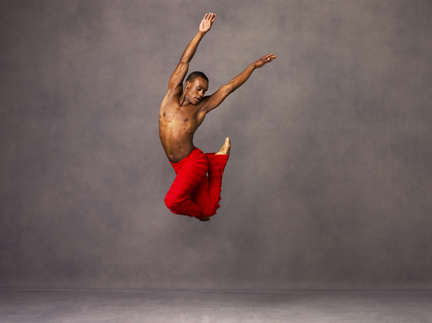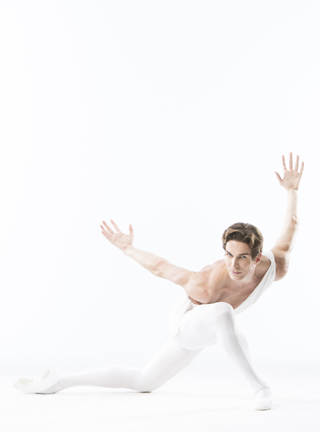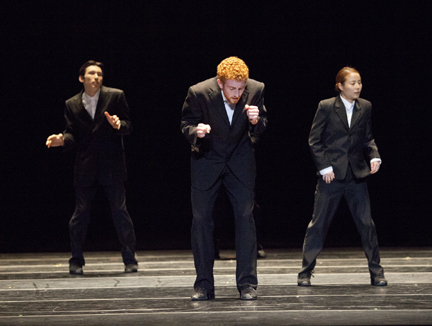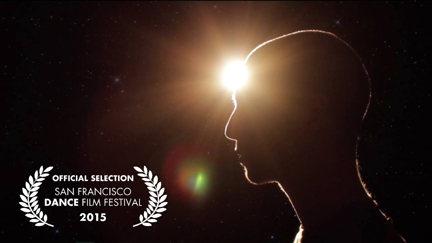Solitary Ballet in the Time of the Pandemic
© Reviewed by John Arkelian
“Lost in the Right Direction” (Canada, 2020): This improvisational dance collaboration was devised by dancer, ballet

© 2020 by Linda Arkelian – from the short film “Lost in the Right Direction”
teacher, and choreographer Linda Arkelian and features several dancers from Vancouver’s Lamondance. It’s a reflection – in movement and music – on the isolation born of the global COVID-19 pandemic. Each dancer contributes a few seconds of improvised dance to solo piano music by the young Dutch composer and pianist Muriël Bostdorp, whose gentle, poignant, and introspective music gives this dance short its name. The music speaks of both loss and acceptance; its sadness is intermingled with welcoming of what comes next. Appropriately, then, the closing movement of each brief section of dance becomes the starting movement of the following section, resulting in a seamless depiction of balletic cause and effect. Each dancer was free to express the style and mood suggested to them by the music and by the film’s theme: There are moments of melancholy here, as well as pent-up energy and the impulse to break free from the virtual walls that separate us in this time of self-sequestration, social distancing, anxiety, and quarantine. One dancer is sandwiched between two looming, oppressive walls; another tests the unseen barriers that surround him, like a mime in an invisible box; a third has only her own reflection for company. Arkelian herself is perched among the intertwined roots and trunks of large trees: clad in flowing mauve, she’s kin to Tolkien’s elvin Luthien, who danced under the boughs of the greenwood when the world was still young. The video ends with her representation of a pulsating heartbeat, a sign, doubtless, that life endures and prevails. The collaborative result, edited by Lamondance’s artistic director Davi Rodrigues, is lyrical. The video is about three minutes long:
**********************************************
Fall for Dance North 2019
© By John Arkelian
It’s hard not to fall for “Fall for Dance North.” Where else can
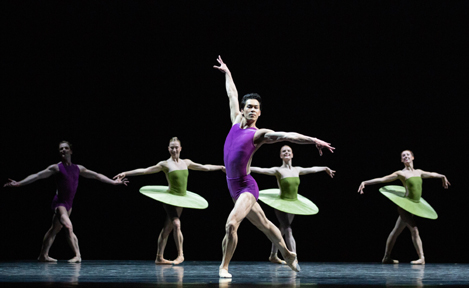
The National Ballet of Canada in “The Vertinginous Thrill of Exactitude” (photo by Karolina Kuras) — courtesy of Fall for Dance North.
you see such a cornucopia of dance forms – ballet, modern, jazz, street dance, and ethnic dance – at one time and in one place? As always, the twin goals of the festival are diversity and accessibility. And it doesn’t get any more accessible than $15 for any seat in the very large venue now called Meridian Hall (formerly the Sony Center) in downtown Toronto. This year’s festival (on October 2-6) offered three separate programs, five performance dates, eleven dance companies from around the world, packed houses, free programs (at the commuter hub of Union Station), open studios, and artist talks. We saw the eclectic Program Two (on October 4th), and it consisted of four acts.
First up is Shantala Shivalingappa (born in India and based in
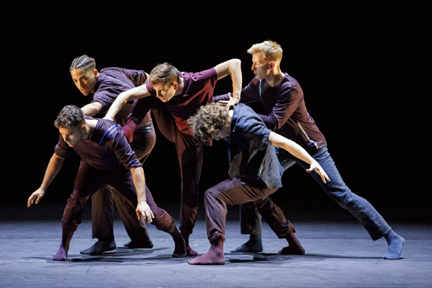
Ryerson School of Performance in Anne Plamondon’s “Fiddle Embrace” (photo by Bruce Zinger) — courtesy of Fall for Dance North.
Paris), whose abstract interpretative solo, “Shiva Tarangam,” recalls Hindu mythology. Four male musicians (one is a vocalist, the others play percussion, flute, and a stringed instrument from the subcontinent known as a ‘veena’) give musical voice to the dancer/choreographer’s artful blend of delicacy and precision. The uninitiated may not glean the precise significance of this subtle hand movement or that carefully calibrated leap; but there’s no missing the fact that every element is imbued with meaning.
Next up is a street dance piece for five dancers called “Conversation” from Toronto-based dancer and choreographer Caroline “Lady C” Fraser. It’s a world premiere, commissioned for this festival. And, it’s as though the non-physical gives birth to the physical, as the original score (by the four-man, on-stage band “re.verse:”) finds visceral form and expression in the dancers’ interpretive movements. One streetwise and cocky section sounds like it could be from the soundtrack for the movie “Shaft.” Throughout the
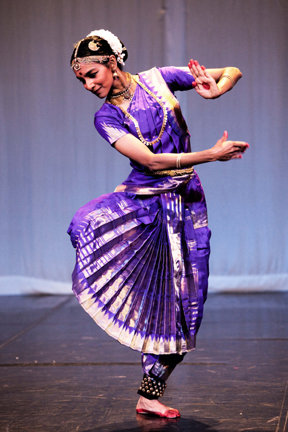
Shantala Shivalingappa in “Shiva Tarangam” (photo by Hector Perez) — courtesy of Fall for Dance North.
piece, sound waves are transmogrified before our eyes into dance moves. A nearby wag likens the sound to ‘the funky guitar scratchings of the Seventies’ and to a 1976 song called “The Year of the Cat.”
During the intermission, we get a surprise visit from Canadian figure skating phenom (and inveterate entertainer) Kurt Browning and several members of this year’s CBC-TV’s “Battle of the Blades.”
The second half opens with five dancers from The National Ballet of Canada performing William Forsythe’s 1996 piece “The Vertinginous Thrill of Exactitude” with a live orchestra. The emotive final movement of Schubert’s Symphony No. 9 swept us along with its life-affirming vivaciousness and hints of the joyous. Three women in pale green, corseted with flat and rigid circular pancake tutus, and two men in what looked like purple lifeguard outfits, reinterpreted classical forms in a muscular, sharper edged-style – marrying the oft-spritely music with sinewy movement. For some reason, geometry comes to mind in watching this piece.
Last, but not least, comes our favorite piece of the evening, “Fiddle Embrace,” choreographed by Montreal-based Anne Plamondon, and performed by 18 dancers from the Ryerson School of Performance. Plamondon seeks “moments of grace” in dance, and this modern dance piece has many. Commissioned for this festival, it conjures a vision of a near-future dystopia, with rebellious proles in somber-colored dance overalls transitioning from writhing movements to regimented moments to freedom and fluidity. Like something out of William Morris’ 1888 “A Dream of John Ball” (and its imagining of the 1381 Peasants’ Revolt), the underclass of humanity evolves from ceaseless toil to unshackled, unrepressed creativity. The notion also harks back to John Ruskin’s 1851“The Stones of Venice” and its romanticized vision of the building of the great cathedrals of the Middle Ages, which gave scope to every participant to bring their individual creativity and improvisation to bear on the great task at hand. One section has pianist Carol Solomon on stage, behind a gauzy curtain; elsewhere, percussion and synthesizers predominate. The eighteen dancers have a large following (of presumed classmates) in the audience, and they roar with approval – to which we can only add our enthusiastic own.
Copyright © 2019 by John Arkelian.
Editor’s Note: “Fall for Dance North” celebrated its fifth consecutive year on October 2-6, 2019 at Meridian Hall (formerly the Sony Center), at Ryerson Theater, and at Union Station in Toronto, Ontario. Visit the festival at: https://www.ffdnorth.com/
**********************************************
“Tchaikovsky: Pro et Contra”
© Reviewed by John Arkelian
“I have always tried to understand why the composer [who]
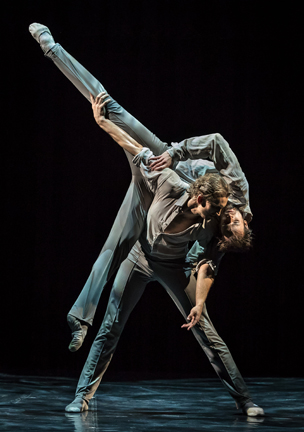
“Tchaikovsky: Pro et Contra” (photo courtesy of Eifman Ballet of St. Petersburg).
reached enormous fame and completely fulfilled his gift, created such tragic music? There is no doubt: the main source of the torment that withered his soul was the oppressive awareness of his own otherness…”
So says Russian choreographer Boris Eifman about Pyotr Illyich Tchaikovsky, the subject of his ballet “Tchaikovsky: Pro et Contra,” presented at Toronto’s Sony Center by the Eifman Ballet of St. Petersburg.
It opens with the composer on his deathbed and jumps back to earlier moments in his life. As he treads the stage of his own personal and professional life, he is never alone. His constant companion, tempter, muse, guide, and tormentor is the alter ego that represents his darker, transgressive side – but who may also be intimately connected to the well-spring of his creativity. Indeed, duality, pairings, and doublings figure prominently in this ballet’s choreography and staging. So do a profuse intrusion of dream images into the composer’s imaginings: swans (courtesy of a classical corps de ballet), militant mice, a nutcracker, and madcap gamblers – all gleaned from his ballets – swirl around him and

“Tchaikovsky: Pro et Contra” (photo courtesy of Eifman Ballet of St. Petersburg).
sometimes overwhelm him. The source of much of the character’s angst is signaled by recurring all-male pas de deux. It’s his alter ego he is dancing with and set against, but also his transgressive sexuality. There are numerous images of sex and death – often paired in a frenzied, self-destructive union.
The Eifman Ballet restricts itself to very tall dancers (in the range of 5’8” for women, 5’11” for men) and proudly displays their consequent long lines; but, we wouldn’t have minded more diversity of height among the troupe. The dance style, which some critics have assailed as garish and over-the-top, according to dancer Daria Reznik, combines classical ballet with elements more akin to modern dance – chief among them, staccato, truncated movements. One

“Tchaikovsky: Pro et Contra” (photo courtesy of Eifman Ballet of St. Petersburg).
character in an early scene has a limp rag-doll physicality. We liked best the reminders of such great classical ballets as “Swan Lake,” with the dancers in traditional white tutus.
Musically and dramatically, we preferred the ballet’s second half. The first act was dominated by Tchaikovsky’s Fifth Symphony; whereas the musical sourcing for Act Two (his Serenade for Strings; Capriccio Italien; and Sixth Symphony) had more emotional traction for us. The ballet’s two great standout scenes both come in the second act. One has a frenetically surreal gathering of ‘all-in’ card players at a wildly askew card table (an inventively used prop). The other is the most memorable scene of all – pairing two couples: In the foreground, a man sits looking away from a woman, whose arm reaches out yearningly toward the impassive figure; in the background, a couple stands on a curved bridge (as if over a meandering stream), their posture mirroring that of the other couple., while the painful breach between them becomes literal as the bridge upon which they stand separates into two halves. In a ballet about the vortex of creativity and emotional anguish, it is a perfect moment and an artful tableau.
Copyright © 2019 by John Arkelian.
Note: The Eifman Ballet’s “Tchaikovsky: Pro et Contra” played at the Sony Center in Toronto on May 9-11, 2019.
**********************************************
Fall for Dance North 2018
© Reviewed by John Arkelian
Let devotees of dance rejoice! Fall for Dance North, the

Introdans (courtesy of Fall for Dance North).
phenomenal celebration of all things dance, returned to Toronto for its fourth consecutive year on October 2-6, 2018. This international festival is an annual embarrassment of riches, showcasing the best ballet, modern dance, jazz, ethnic dancing, and dance forms that defy easy categorization from around the world. This year saw three programs presented in six shows across five days at two venues (with the Ryerson Theater supplementing the traditional venue at the Sony Center). And commuters were treated to free programming at Union Station. Artistic director Ilter Ibrahimof and his team have once more combined quality and diversity (of form and national origin) in the dance companies on offer. The evening program on Friday, October 5, 2018 at the Sony Center
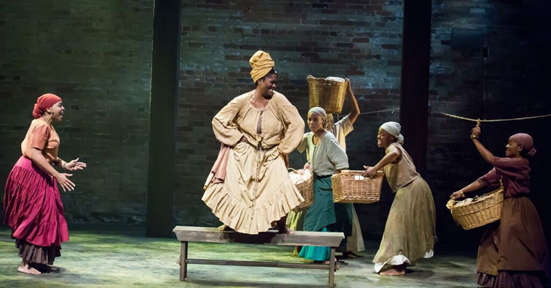
Obeah Oera 2019 (courtesy of Fall for Dance North).
was proof positive of that.
First up was Introdans from The Netherlands with Gustav Mahler’s “Lieder Eines Fahrenden Gesellen” (“Songs of a Wayfarer”), with a succession of five couples, each performing a pas de deux, variations on a theme of what struck us as ‘Aspects of Love.’ A mezzo (Georgia Burashko) sang the German lyrics as fellow musicians from the Glenn Gould School performed the score. Choreographed by Jiří Kylián, it was classical ballet at its most intimate, graceful, and emotive, as the moods ranged across first love, sadness, and jealousy.
Obeah Opera 2019 was worlds away from ballet in style, look, and sound. A large troupe of black women were attired in floor-length skirts of red, yellow, turquoise, and purple, with white blouses and
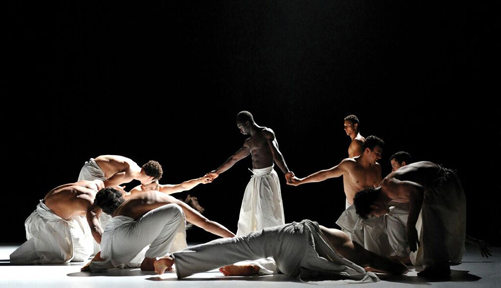
Compagnie Herve Koubi (courtesy of Fall for Dance North).
voluminous white skirts. Blending such genres as spirituals, gospel, blues, calypso, and reggae, this lively, theatrical result was a marriage of “Show Boat” and the Afro-pride of the Black Panther’s Wakanda, with a playful soupçon of Santeria or voodoo thrown in for good measure. A high priestess (and chief vocalist) presided over her tribe sporting a palm-shaped fan that doubled her height. The result (excerpts of the full piece were presented), from Toronto-based director Nicole Brooks and choreographed by Anthony ‘Prime’ Guerra, was colorful, lively, and wonderfully theatrical; indeed, we’d love to see this piece incorporated as a dance section in a full-fledged stage musical about the black diaspora in North America: “In the beginning was the beat, and from the beat
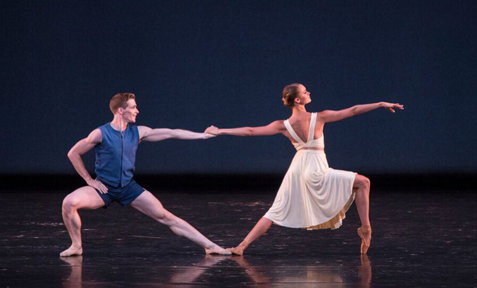
The National Ballet of Canada (courtesy of Fall for Dance North).
begat the dance.”
The National Ballet of Canada presented “Paz de la Jolla,” with eighteen dancers conjuring a summer at the beach and first love. Their bright swimwear was muted at times with gauzy overlays, turning swimmers into a representation of the water itself. Choreographer Justin Peck evidently had in mind an homage to his native southern California, with music composed by Bohuslav Martinů (and performed by the company’s own orchestra). It was a coming of age story performed as classical ballet, in a lovely and spritely evocation of youth
Companie Hervé Koubi, from France, was on hand with excerpts from “What the Day Owes the Night,” a tour de force of movement that brought to mind a head-on collision between gymnastics and the urban obstacle-course running style known as parkour. Twelve bare-chested men wore white split-skirts over white pants as they leapt and spun like whirling dervishes. It was muscular and masculine – a bravura display of athleticism that combined sheer physicality with an unexpected variety of fluid, toned artfulness, all to the exotic tones of music that would not be out of place in North Africa.
We can’t wait for next year. Meantime, we’d be delighted to see stand-alone programs from any of the four companies featured on October 5th.
Copyright © 2018 by John Arkelian.
**********************************************
Mark Morris Dance Group’s “Pepperland”
© Reviewed by John Arkelian
“It was twenty years ago today / Sgt. Pepper taught the band to play / They’ve been going in and out of style / But they’re guaranteed to raise a smile.”
The Mark Morris Dance Group brought “Pepperland,” its homage to The Beatles, to the Sony Center in Toronto on February
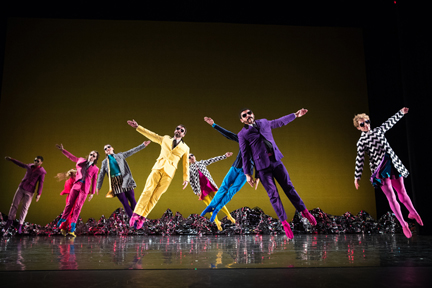
Mark Morris Dance Group in “Pepperland.”
24, 2018. Their specific inspiration was the album “Sgt. Pepper’s Lonely Hearts Club Band.” But have the music and look of the ‘Fab Four’ gone out of style in the half-century since that album appeared? What we got was a program of roughly an hour (without intermission), featuring dancers (of surprisingly diverse body types) and the troupe’s own in-house musicians. Prominent among the latter were a male vocalist and a man playing the theremin. The dancers were attired in a rainbow of bright colors in a psychedelically bright interpretation of garish Sixties’ garb. And they often sported sunglasses. But those eye-coverings distanced the dancers from us and created a certain strutting haughtiness in the personas they embodied on stage. The music was sometimes
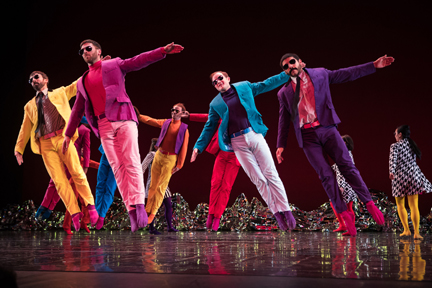
Mark Morris Dance Group in “Pepperland.”
jazzy; at other times bringing to mind ragtime or burlesque, with recurring chorus line motifs, and some Bach influences along the way. At one point, something brought a harpsichord to mind. Trouble is: neither the music, nor the somewhat repetitive choreography engaged us. There was no discernible story to what unfolded, just dancers coming and going (sometimes as if in processions) in varying combinations. Were they representations of hippies? Did this hark back to some half-imagined ‘summer of love?’ We didn’t have a hook on which to hang an emotional reaction. Neither moved nor captivated, we were left feeling, well, rather bereft and detached. It seemed to us that the program was a study in deliberate dissonance and disharmony, which left the viewer an inchoate blank page in lieu of thrills or inspiration or moments to be emotionally moved. The inimitably otherworldly theremin, which can work eerie wonders in the right setting (like the classic 1951 film, “The Day the Earth Stood Still”) felt intrusive here, calling attention to itself. What we liked best was the concentric circles formed by the dancers at the end. The dancers clearly were able; we’d just be glad to see them in a different work.
Copyright © 2018 by John Arkelian.
**********************************************
Fall for Dance North – Year Three
© Reviewed by John Arkelian
The Sony Center was home to three different programs on three
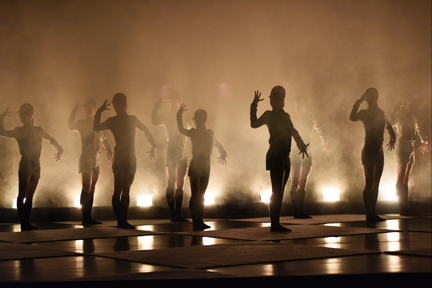
From Gauthier Dance’s “ConrazonCorazon” (photo by Regina Brocke).
nights, as the wonderful Fall for Dance North returned for its third year on October 4-6, 2017. Designed to expose dance aficionados and dance novices to an eclectic diversity of different forms of dance – like classical ballet, modern dance, jazz, ethnic dancing (this year included the Canadian practitioner of Irish dancing, Michaela Hinds), and, this year, street dancing – it’s an annual treat for its enthusiastic capacity audiences, courtesy of artistic director Ilter Ibrahimof and his talented team. Each night’s performance is preceded by artist talks, in which the participating dancers, choreographers, and musicians give us a behind the scenes look at the work we’re about to see. For instance, we learned that Laurence Lemieux first appeared in this evening’s piece in 1991 – a
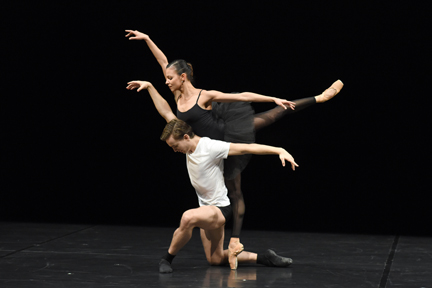
From Gauthier Dance’s “Ballet 102” (photo by Regina Brocke).
mark of the commendable staying-power of both the choreography and her!
The third program (on closing night) consisted of four pieces. The evening opened with “Ballet 102” from Gauthier Dance/Dance Company Theaterhaus Stuttgart, based, as their name suggests, in Stuttgart, Germany. It’s a playful piece for a single pair of dancers (Barbara Melo Freire & Theophilus Vesely) in which an unseen narrator enumerates 102 positions of the classical pas de deux, with sly nods to famous choreographers from the past. The first time around, we get a straight countdown, from 1 to 102, as the dancers effortlessly move from one to another. Then, things get inventive, and frenetic, as the narrator calls out position numbers in
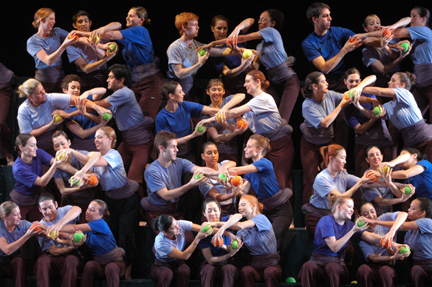
From “72 Person Ball Passing” (photo by Stephanie Berger).
seemingly random order. Odd sound effects add to the fun in this fast-paced, funny introduction to the form.
The pace changes for the next piece, though, it, too, focuses on the pas de deux. Here, Citadel + Compagnie (helmed by the aforementioned Laurence Lemieux) presents “Fifteen Heterosexual Duets.” As the name implies, we see a succession of 15 duets, each with a different couple. The choreography by James Kudelka is meant to illustrate the dynamics of 15 different relationships between man and woman. It’s all to the strains of Beethoven’s “Kreutzer Sonata No. 9 in A Major,” which is performed live on stage by Andrew Burashko on piano and Sheila Jaffé on violin. Various couples seem to embody different themes: One is formal, another fluid; here there’s turbulence, there passionate attachment. These are elegant studies in synchronicity, a recurring theme of the evening. (Our favorite duet had a willowy blonde, with her head always tilted downward, signifying, perhaps, either modesty or unhappiness, attired in a pale blue top and pale green skirt.) As technically adept as the ensemble and the musicians were, however, the lengthy piece failed to engage us. The problem lay with the choice of music, which, frankly, became monotonous; despite changes in tempo, the composition had a repetitive sameness to it that lulled rather than heightened our senses. We’d prefer the piece be reset to wholly different music.
Gauthier Dance returned to the stage after the intermission, with “ConrazonCorazon” (which translates as “With Reason and Heart’). It opens with ten dancers arrayed like pieces on a chessboard surface divided into alternating black and white squares. Initially, they are rendered all but invisible by the glare of bright lights at floor level. Gradually, they take form, each of them wearing a horse-jockey’s black cap and attired in grey sleeveless shirts, grey shorts, and knee socks. It creates a unisex look, though, frankly, we weren’t keen on the shorts and socks. By contrast, we were very keen indeed on the music (vocal pieces in French and Spanish) and on the comedic fun of the choreography and performances. It’s meant to convey the push and pull between human reason and human feeling, though, for us, that obscure meaning played second fiddle to the sheer visual entertainment of the piece. (It was interesting to see the notable difference in height between different members of this talented troupe, a differential that is unusual in dance, but not at all unwelcome.)
Each of the three programs this year ended with a piece specially commissioned for Fall for Dance North: 72-Person Ball Passing, choreographed by Charles Moulton, had 72 men and women of different ages in six very steeply tiered rows. This impromptu bit of stadium seating was so steep, in fact, that it was practically vertical, giving the impression that we were looking at a square of massed humanity from above them. Here synchronicity was celebrated in its full glory – sometimes flowing, sometimes artfully mechanical, arms and upper torsos moved in unison or in wave patterns, with brightly hued balls as props. It was so artfully composed that in one section we perceived only the gently waving hands of the performers, with the rest of their bodies merging into a static background. While the piece might have gone on a tad longer than its concept required, it was a crowd-pleaser, a visual treat, and an inventive, satisfying way to close out the show. (In a bit of very good thinking, the piece was restaged at Union Station, free, for commuters to enjoy, on the weekend following the three-day festival.)
We can’t wait for Fall for Dance North’s fourth iteration. The program we saw this year might not have been quite as thrilling as its predecessors over the past two years, but that’s quibbling, because it was a lovely night at the dance!
Copyright © 2017 by John Arkelian.
**********************************************
Red Giselle: The St. Petersburg Eifman Ballet returns to Toronto
© Reviewed by John Arkelian
The St. Petersburg Eifman Ballet celebrated its 40th
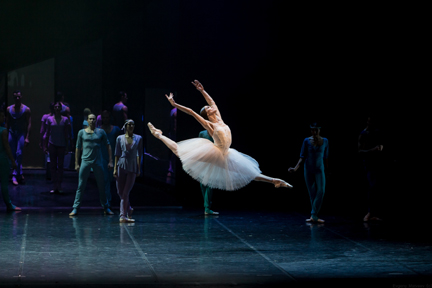
“Red Giselle” courtesy of St. Petersburg Eifman Ballet.
anniversary with its third visit to Toronto: In April 2017, the Sony Center was host to four performances of “Red Giselle” by the company’s 70 year old founder, artistic director, and choreographer Boris Eifman. Intended as a tribute to the great ballerina Olga Spessivtseva, the ballet traces the tragic trajectory of her life – from artistic acclaim, to a destructive love affair (in the midst of violent political and social upheaval), and thence to exile abroad, romantic betrayal, and madness. Its characters are known by descriptive nouns rather than names: Ballerina, Teacher, Commissar, and Partner. Its music is gleaned from the work of Peter Tchaikovsky, Alfred Schnittke, Georges Bizet, and Adolphe Adam.
The setting is the Russian Revolution, with its overthrow of a long
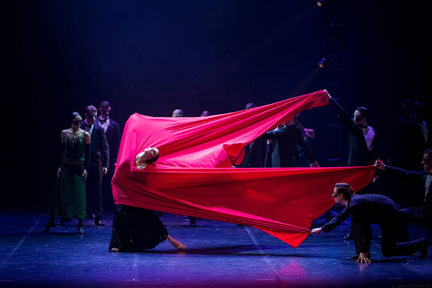
“Red Giselle” courtesy of St. Petersburg Eifman Ballet.
established monarchy by the ideological tyranny of communism. But, on a deeper level, what’s really at play here is a head-long collision between Apollonian and Dionysian principles. These are exemplified in the contrast between the two competing alpha males in our heroine’s life. The Teacher is the ballet company’s exacting dance master. We go behind the scenes as the ballerinas practice at the barre and join them on stage as they perform in a gilt St. Petersburg theater. The Teacher represents order and rationality and decency. His diametric opposite is the Commissar, who half seduces, half ravishes the Ballerina. Attired all in black, with thigh-high boots and long leather coat, he represents the destructive principle – and disorder. The mannered theater audience gives way

“Red Giselle” courtesy of St. Petersburg Eifman Ballet.
to a coarse and ribald street revel (this ballet’s version of a peasant dance section). But these common folk are full of barely suppressed violence and vileness – man’s worst impulses which the cynical oppressors represented by the Commissar are all too happy to use to their own ends, whipping the masses into a wild frenzy. At first, the Ballerina is frightened and appalled by which she sees, but she is overpowered by her lover to join in and lead the rabble.
Is the Ballerina a hapless victim of romantic and sexual passion? In part, perhaps. But, there is as much violent compulsion as willful blindness in her attachment to the Commissar. He represents, and, indeed, seems to revel in, the defilement of purity. His malign influence (and that of the totalitarian ideology he serves) spreads to
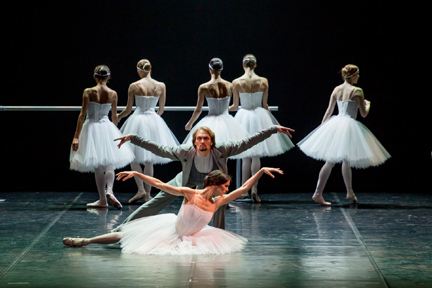
“Red Giselle” courtesy of St. Petersburg Eifman Ballet.
the rest of society: The Teacher is taken and brutalized; the other dancers turn to the dark side. There’s an effective martial section to drumbeats, with the Commissar’s fellow enforcers of the revolution all in black leather: they brutalize others with the sinister strut of machismo. Herein lies a paradox: That which may seem boldly seductive may, to a keener eye, be more accurately perceived to be destructive and rapacious. Today, we are again witnessing the reawakening of nationalism, xenophobia, and cynical populism in the West, as well as hateful ideologies elsewhere. Ours is a time (once more) when, as the poet W.B. Yates said, “The best lack all conviction, while the worst are full of passionate intensity.” And there’s a Gothic, psychologically vampiric, aspect to the Ballerina’s seduction at the hands of the Commissar, combining as it does, a mixture of fear, loathing, and helpless attraction. But not entirely helpless: At the end of Act One, she flees, becoming a refugee and going abroad into an unknown new life, just as thousands of refugees do today.
In the second act, the Ballerina is in Paris – alone, traumatized by her experiences, and in the unaccustomed role of an outsider. There’s a dryly amusing sequence where she joins a French dance company: They’re all dressed in pastel shirts and slacks; and not just their attire is unfamiliar. Their modern dance moves are alien to her, for she is the paragon of classical ballet and classical technique. She tries to fit in, drawn to the man who becomes her Partner on stage and in love. But his true affections lie elsewhere. This act’s equivalent to a folk dance number comes in the refreshing form of a Parisian nightclub, with the company doing unballetic dance to the tune of “Yes Sir, That’s My Baby” and other jazzy music of the sort favored by the time’s ‘flappers.’ But the Ballerina is haunted by memories of her past life. And when her new dance company puts on a production of “Giselle,” a scene from which is shown here as a ballet within this ballet, life imitates art in our heroine’s tragic disappointment in love and her ensuing descent into madness. Are those veiled brides wearing stylized straight-jackets for sleeves? To be mad can entail being locked within one’s own mind, bereft of compass, or being trapped inside one’s own deep despair: That plight is nicely conveyed here at the ballet’s end by the use of moving, partially blurred mirrors. Does a clamshell glass structure represent a concert hall’s rooftop copula turned on its side – reality turned askew perhaps? It’s the ballet’s only ineffective visual element. Everything else here is a sheer delight – from the inventive choreography, which combines classical ballet with movement from modern dance (and even, seemingly, from ice dance); the powerful story, with its palpable resonance for modern audiences; and the exquisite dancing. “Red Giselle” left us rapt. Bravo!
John Arkelian is an award-winning journalist and author.
Copyright © 2017 by John Arkelian.
**********************************************
Batsheva Dance Company in a Captivating Anthology of Dance
© By John Arkelian
Toronto’s Sony Center hit another home run on January 14, 2017

Batsheva Dance Company – photo by Maxim Waratt.
with their presentation of Batsheva Dance Company. Based in Tel Aviv, this 52-year old company is at the top of their game, widely regarded as one of the world’s foremost contemporary dance troupes. And they made true believers out of us, bringing what appeared to be a capacity (3,200-seat) house to its feet with thunderous applause with a program dubbed “Deca-Dance 2017” that comprised an anthology of early work by the choreographer Ohad Naharin, who is back at the helm of Batsheva as its artistic director. In an amusing prelude, as the audience assembled, a solitary male dancer did an impersonation of a marionette come to life, with jerky, angular movements. That same interior monologue style was in evidence in the show’s opening section, with each dancer
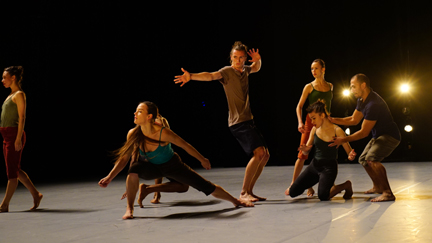
Batsheva Dance Company – photo by Maxim Waratt.
moving to the tune of his or her own drummer, even though in unison. For punctuation, we got a loud rock-driven version of Hava Nagila. When the curtain went back up, the full ensemble (of 18 dancers) was in dark suits and hats, sitting on chairs in a sweeping semi-circle. A choreographed version of a sports stadium’s “wave” ensued, with quick, sharp, repetitive, deliberately jerky motions spread along the curved array of dancers like a current, each ripple concluding with a loud vocal cry. And current is the word for it. It’s an electrifying piece, one we saw the Atlanta Ballet perform on the same stage at 2015’s “Fall for Dance North” extravaganza. And what a thrill to see it again: It’s a show-stopper!
Later segments had a half dozen men in grey shorts to the sound of
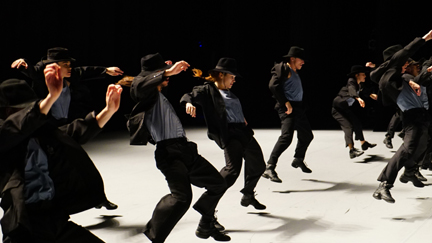
Batsheva Dance Company – photo by Maxim Waratt.
loud ticking, then a line of alternating genders with individuals taking their turn breaking into wild frenzied movement to the accompaniment of exotic music. Then, the house lights came on and the dancers wandered into the auditorium, each of them selecting an impromptu partner from the audience. (My friend is offered a chance to dance, to my delight, but she demurely declines.) With 18 new partners in tow, an improvised discotheque jumps to infectious life on stage. Are these drafted players truly unschooled and unrehearsed? It’s hard to believe, since most acquit themselves surprisingly well. They’re pretty darn convincing for amateurs (though, the odds are that there are many dancers, dance teachers, and students of dance among the audience). In the end, only one
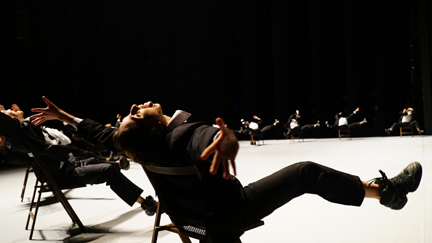
Batsheva Dance Company – photo by Maxim Waratt.
couple remains, dancing to a crooner to the crowd’s delight.
Energy, originality, and sheer joie de vivre were the show’s hallmarks. Hailing both from Israel (a protest in front of the theater on the chilly night drew the audience’s attention to the idea of boycotting all things Israeli, cultural ones included, in order to pressure that country’s government to change its policies toward the occupied Palestinian people) and other countries, these dancers (Nitzan Ressler was one who made a singular impression), and this choreography, were a pleasure to behold. We can’t wait to see them again!
Editor’s note: Next up for us is St. Peterburg’s Eifman Ballet, who’ll be bringing their Red Giselle to the Sony Center on May 11-13, 2017. Visit http://www.sonycentre.ca/ for details.
Copyright © 2017 by John Arkelian.
**********************************************
Stop-Motion: Nederlands Dans Theater Returns
© By John Arkelian
After a long absence, one of the world’s foremost contemporary
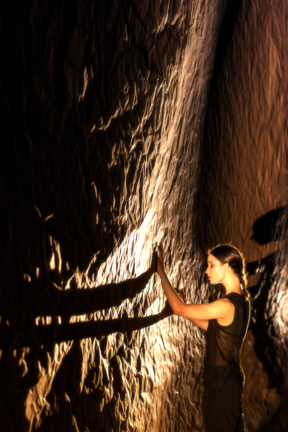
From “In the Event” by Nederlands Dans Theater — photo by Rahi Rezvani.
dance companies, Nederlands Dans Theater (NDT), returned to Toronto for a one-night engagement at the Sony Center on November 9, 2016. They presented three works, each of them riveting, in a mixed program that brought the capacity audience repeatedly to its feet. “In the Event” has prominent contributions by Canadians, with choreography by Crystal Pite and production design by Jay Gower Taylor. A floor to ceiling backdrop conjures a rugged rock face, while thunderous rumbling suggests a subterranean vault – some hidden place deep in the roots of the mountains. Life stirs in the deeps, in the form of eight dancers. When we first see them, one is engaged in staccato gestures of arms and hands, a jerky, repetitive motion that’s somehow alien and eerie. Are the ragged forks of lightning aerial electricity or great fissures cracking open in the rock face? The movement here is lithe and spare, in compact formations; while brief snippets of music offer a counterpoint to the sound effects dominated aural-scape.
“Safe as Houses” lets us peek inside a miniature performance box. Or is it the inner works of a great timepiece? A partition wall dissects the stage; then it starts to move, tracing a concentric path as it slowly rotates on a fixed central point, like a fallen white monolith tracing and circumscribing the dancers who move around it. It’s a mesmerizing, inexorable centerpiece for the action – the cosmic clockwork that rules all we living beings do and achieve. The dancers appear and disappear in small groups and duos. Sometimes they assume stationary poses, fixed in station like the hour markers on a great clock. NDT’s dancers are as lithe as ever, with an expert economy of movement. Inspired by the “I Ching” (or “Book of Changes”), this winning piece combines the ultra-modern with the baroque, to the tune of music by J.S. Bach.
“Stop-Motion” closed the program in a virtuoso display of
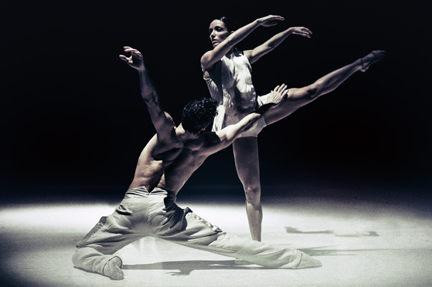
From “Stop-Motion” by Nederlands Dans Theater — photo by Rahi Rezvani.
performance mixed media. Created by NDT choreographers Sol León and Paul Lightfoot, to music by Max Richter, the piece makes arresting use of a large screen onto which a close-up image of the choreographers’ daughter, Saura, is projected. Adorned in rich, baroque-looking clothing that is redolent of another time, she is motionless at first then comes to life in slow motion. There is drama and melancholy in her expression, in a very evocative triumph of minimalist acting. She’s a sad observer, perhaps, of the drama being enacted below her by the dancers. Theatrical use is made of white dust, which brings the sands of time to mind. It’s a dreamy reverie that ends with the projected image of a falcon in flight. Bravo to NDT for three completely immersive, wholly absorbing, and beautifully danced works of contemporary dance!
Copyright © 2016 by John Arkelian.
**************************************************
The Return of ‘Fall for Dance North’
© Reviewed by John Arkelian
Two different programs, with multiple dance companies, creating a

Les Grands Ballets Canadiens (Kravetz Photographics).
veritable smorgasbord of dance, with four shows spread over three days, all at astoundingly low admission prices. It makes for a dance sampler par excellence. That’s the wonderful premise behind Fall for Dance North, which made its second annual appearance at Toronto’s Sony Center on October 5–7, 2016. Dance aficionados and initiates alike will relish the result: Where else to see so many first-rate performers engaged in different forms and styles of dance (classical ballet, modern dance, ethnic dance and more – they’re all represented here) on the same stage in the same show?
The final show of the series devoted its entire first half to Les Grands Ballets Canadiens. This acclaimed Montreal based company presented “Dim Light of Dawn,” choreographed by Ken
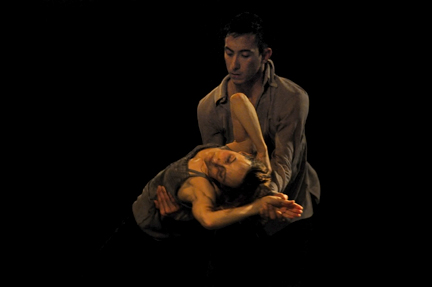
Anne Plamondon & Peter Chu in “A Picture of You Falling” (photo by Michael Slobodian).
Ossola, a series of vignettes to music by Rachmaninoff. A sparse set evokes a forest setting, with columns that suggest tree trunks. Pairs of dancers alternate with small groups of dancers in a work that eschews any sense of overt storytelling in favor of sheer movement and mood. As technically strong as these dancers are, however, the piece failed to engage us. Perhaps it was the monotonous sameness of so much of the music – heavy on piano, it had a repetitive, melancholy rhythm that sounded very much like the studio practice music used during dance class or barre exercises. There was one strong musical exception, however, in the form of a pas de deux to a piece of instantly recognizable, energetically romantic music: It was the piece’s standout section. But, thanks to the choice of music and

Natasha Bakht (Byfield Pitman Photo).
the absence of discernible ‘story,’ much of the rest tended to the soporific, which surprised us, given the eminently high caliber of this company. Mind you, the sound and lighting effects got some wows: cracking sounds conjured a sleet storm; when it turned to rain, a lovely deluge of blue and silver sparkles rained down upon the stage. Another visual highlight consisted of small illuminated spheres that descended on invisible wires, suspended like stars above the dancers, while a dollop of fog hovered in the background.
The second half of the evening was divided among three utterly distinctive participants. First up was “A Picture of You Falling,” choreographed by Crystal Pite, and performed by Peter Chu and Anne Plamondon. A dozen floodlights on stands created a kind of

Ukrainian Shumka Dancers in “Classic Hopak” (Ellis Photo).
stage within a stage (another light moved from place to place), and a female narrator’s (Kate Strong) authoritative voice added to the sense that perhaps we were watching characters within a novelist’s mind, creating and recreating moments from a story she was devising, or maybe remembering. The dancers’ staccato movement style likewise brought to mind the unseen attached ‘strings’ that yank us hither and thither in life – strings made out of regrets, of failures, and of getting up and trying again: “This is a picture of you, falling…. This is how you collapse. This is the sound of your heart hitting the floor.” The result was an engrossing, extended pas de deux.
Next up was Natasha Bakht’s “786” (the title is a numeric distillation from the letters of an important phrase from the Koran. Bakht, who is a professor of law by day, shared the stage with two musicians – one on a drum and cymbals kit, the other on a cello and then an electric guitar. Their rock music riffs played out against her unique dance style which combined the angular movements of South Asian dance, with contemporary dance movement, and even elements from yoga. Here was a thoroughly modern Muslim woman in an engaging pastiche of eclectic dance styles (much like Fall for Dance North itself), bringing those diverse influences together in unique and effective ways.
The evening came to a rousing close with “Classic Hopak,” choreographed by John Pichlyk, an audience-pleasing kaleidoscope of frenetic movement and swirling color performed by the Canadian-based Ukrainian Shumka Dancers. 40 or more dancers in bright ethnic costumes brought manic energy to the fast-paced lively music. It was ethnic flavor to the ‘nth’ degree: the men with acrobatic leaps and low-on-their-haunches kicks; the women in more demure mode, moving forward, then back in a joyful line. It was utterly infectious fun – and a great way to close a great series, to thunderous applause. We can’t wait for Fall for Dance North’s return in 2017!
Copyright © 2016 by John Arkelian
**************************************************
Alvin Ailey American Dance Theater Wows Toronto!
© By John Arkelian
Alvin Ailey American Dance Theater came to Toronto’s Sony Center in March 2016 for three performances over two days – and

Alvin Ailey American Dance Theater in Robert Battle’s “Awakening” (photo by Paul Kolnik)
they left us well and truly wowed! “Four Corners” featured eleven dancers in choreography by Ronald K. Brown that juxtaposed spare muscularity with music that ran the gamut from Afro-American to jazzy to folksy. Here, old Africa met the modern as things morph from a solitary dancer in African head-cover to pairs to a group. “Awakening,” choreographed by the company’s artistic director Robert Battle, had dramatic, sometimes ominous bursts of music (by John Mackey), with its dancers clad all in white. It conjured a tragic, epic dance of the firmament, with galaxies and constellations merged and spinning apart under the pull and thrust of gravitational forces. Inventive lighting design (by Al Crawford) had grids and lines used to inventive effect. Its celestial ebb and flow reminded us of something you’d see at a planetarium, with music that began with staccato bursts then became fully symphonic. “A Case of You,” choreographed by Judith Jamison – to music by Joni Mitchell, performed by Diana Krall (both of them Canadians) – was an engrossing, seductively romantic pas de deux, with the woman in a sexy red dress: “You’re in my blood like holy wine / I could drink a case of you.”
“Revelations,” choreographed by Alvin Ailey to Afro-American spiritual music, had three distinct parts. The first, “Pilgrim of Sorrow,” is itself subdivided into three sections: in the opening one, its beseeching figures have heads turned upwards and hands raised in supplication, before they assume an arrowhead formation with its apex at the front. The first part ends with a duo to the spiritual “Fix Me Jesus. The second part, “Take Me to the Water” is redolent of the South, with white parasol, long dresses, and long strands of blue cloth that conjure waves – perhaps ripples on the metaphorical River Jordan or perhaps a reminder of the waves that born Africans to the New World in bondage? Part two ends with an exuberant spiritual called “I Want to Be Ready.” The third part, “Move, Members, Move” opens with the refrain “Old sinner man, where you gonna run to?,” as women in bonnets and men in shirts with vests transport us into the heart of a time and a history and a culture that saw endurance overcome oppression and spiritual exuberance fortify against great hardship. There are echoes of ethnic roots here, overlaid with Christian religious faith.
Copyright © 2016 by John Arkelian
**************************************************
Fall for Dance North 2015
© Reviewed by John Arkelian
Dance lovers rejoice! Following in the footsteps of similar events in New York and elsewhere, Toronto launched the debut of a stunning
new dance festival on three nights (September 29th through October 1st). “Fall for Dance North” was designed to bring dance to as broad an audience as possible. And at the heart of its raison d’être was the goal of introducing novices to the art of dance, in the form of an audience who might not otherwise attend dance programs. Ballet and modern dance programs are expensive to attend, beyond the means of some to afford. Others might simply shy away from attending something unfamiliar. But if cost and lack of familiarity with the art form are impediments in the way of drawing potential new audience members, Fall for Dance North deftly eliminated those obstacles in one brilliant stroke: Every seat in Toronto’s 3,100-plus seat Sony Center was on offer for the
stupendous price of a mere ten dollars. It was a grand jeté of a promotional idea! Presenting two different programs over three nights, the festival offered not just a grand bargain of affordability but also great diversity – of dance forms, styles, disciplines, companies, choreography, and music. In the process, newcomers (in the audience) were exposed to a wide array of dance forms – from classical ballet to modern dance to ethically-inspired dance. And existing dance aficionados (of, say, ballet) got a chance to sample forms of dance (from, say, India) that they might otherwise never see. The greater Toronto region is already home to some acclaimed film and theater festivals. Now, we have a dance festival to match! And the capacity audience rewarded the festival participants with well-deserved sustained thunderous applause and standing ovations!
This particular member of the audience was at once awe-stuck, mesmerized, and thoroughly enchanted by the bravura dance on
show on opening night. There were six pieces by six different dance companies. The National Ballet of Canada was represented by dancers Kathryn Hosier and Evan McKie in the balletic “No. 24,” a duet choreographed by Guillaume Côté to the strains of Paganini. Then six dancers from Toronto Dance Theater amazed us in Christopher House’s “Vena Cava,” a work that’s aptly self-described as “a tour de force of lightning-fast, rhythmically thrilling dancing” to Robert Moran’s memorable music “Open Veins.” With men attired in short, kilt-length red skirts, and women clad in longer skirts of the same color, the piece flew to the very heart of passion, drama, and exuberance. Next up was Alvin Ailey American Dance Theater’s “Takademe,” choreographed by Robert Battle. A
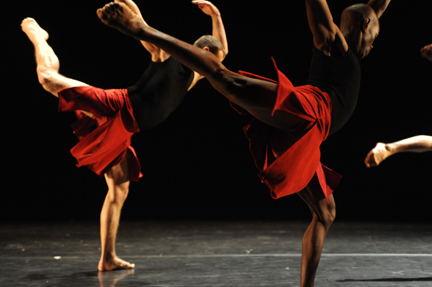
Brodie Stevenson & Pulga Muchochoma in Toronto Dance Theater’s “Vena Cava” (photo by Guntar Kravis).
lone male dancer (Kirven Douthit-Boyd) features in a lithe, gymnastic embodiment of vocal and movement reverberation – all to the staccato monosyllabic vocalizations of Sheila Chandra. Like punctuation marks in wordless dialogue, that music had a dramatically percussive effect, close kin to Inuit singing.
The Nrityagram Dance Ensemble from Bangalore, India presented “Vibhakta,” with two female dancers in traditional attire sharing the stage with four male musicians who melded voice with flute, violin, and other instruments. It was a pleasing introduction to an exotically unfamiliar dance form. The same goes for Inter-Hoop, presented by a quartet of dancers in aboriginal dress from the Six Nations Reserve near Toronto, to the accompaniment
of traditional singing and drumming. The piece was especially commissioned by Fall for Dance North. To this critic’s eye, it was more artful (and gymnastic) prop manipulation (with inventive use made of birch hoops) than dance per se. But, then, it served as a reminder that dance writ large can encompass an almost infinite variety of forms. It was a welcome novelty in this dance smorgasborg: Would its appeal hold up in a program entirely devoted to just this form? Maybe, but maybe not.
The program came to a rousing close with the Atlanta Ballet’s “Minus 16,” choreographed by Ohad Naharin to the music of various artists. Really more a compendium of separate, constituent parts than a single homogeneous piece, it started with a lone dancer in front of the closed curtain. Clad in a business suit, he faces the audience, motionless and impassive – until he doesn’t. Sharp, staccato movements propel him into jerky motion, like a puppet whose unseen strings have by commandeered by a drunken puppet-master. The curtain goes up, and there are soon 19 dancers on stage, all dressed alike in dark suits and hats, all subject to the same anarchistic rhythm which jolts them from a regimen of placid conformity to one of abrupt jerks and twitches. Are they on the receiving end of jolts of electricity from a playful cosmos? Or is the appearance of non-conformity (the dancers shed clothing as they discard their staid mannerisms and posture) nothing but an illusion? For there is a pattern here – even in the midst of intrusion of the rough (and only seemingly random) “got to dance” impulse that takes over these androgynous establishment men (and women). What a way to close the night! And what a night! Fall for Dance North has instantly become a must-see event in Toronto’s calendar of performing arts programs.
Copyright © 2015 by John Arkelian.
**************************************************
Bodies in Celestial Motion:
A review of the new short film “Eclipse”
© Reviewed by John Arkelian
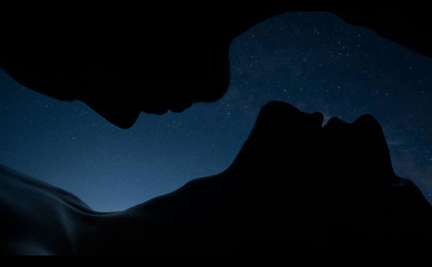
From “Eclipse” — © 2013 by David Cooper & Linda Arkelian.
“Our birth is but a sleep and a forgetting / The Soul that rises with us, our life’s Star / Hath had elsewhere its setting / And cometh from afar / Not in entire forgetfulness / And not in utter nakedness / But trailing clouds of glory do we come / From God, who is our home / Heaven lies about us in our infancy! / Shades of the prison-house begin to close / Upon the growing Boy / But he beholds the light, and whence it flows / He sees it in his joy…”
William Wordsworth “Ode: Intimations of Immortality” (1807) st. 5
In Alfonso Cuarón’s 2013 feature film “Gravity,” there is a striking scene in

From “Eclipse” — © 2013 by Linda Arkelian & David Cooper.
which the scientist-astronaut played by Sandra Bullock, in a brief respite from the mortal dangers facing her, removes her heavy spacesuit and curls up into a free-floating fetal position. The innocence, vulnerability, and grace of that moment also suffuse a new short film from filmmakers Linda Arkelian and David Cooper. “Eclipse” (Canada, 2013) opens with a man’s head and neck in profile — an obsidian silhouette motionlessly looking straight up into the deep blue of near-space, with faint pinpoints of starlight illuminating the void. Then, a second head descends, facing down as its earthbound counterpart faces up — it’s a meeting of ying and yang, with one half of the duo at the right, the other at the left. Then, the blue background
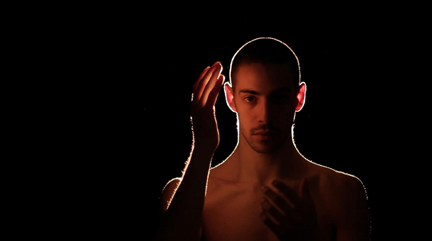
From “Eclipse” — © 2013 by David Cooper & Linda Arkelian.
is gone, and we see the upright heads and shoulders of two male dancers, as a light source akin to a miniature sun passes behind each of them in turn, seemingly entering their eyes and temples, like the metaphorical light of sentience or a spark of sacredness gifted to man by the divine in whose image he is made. Two bodies gyrate in tandem, at moments backlit with only a sliver of light outlining the border where human flesh meets the infinity of empty space. One head leans onto another, then onto a bare chest, for comfort, and mayhap simply for the sense of connection that we all crave. Arms are askew — each of the pair of dancers becoming a Kubrickian star-child reaching out to touch the universe. They swoop and

From “Eclipse” — © 2013 by Linda Arkelian & David Cooper.
turn as if gravity scarcely impedes them at all as they explore and contemplate the universe and their place in it. There’s gentleness and a tender tentativeness to their movements, for they are bodies in celestial motion, beholding all the mystery and subtlety of the cosmos.
“Eclipse” is the second short film collaboration between dancer, choreographer, and actress Linda Arkelian and the acclaimed dance photographer David Cooper. Their first short dance film, “Hands” (Canada, 2012) was directed and choreographed by Arkelian, who also provided that film’s solo performance. For their second effort, they recruited two dancers from Ballet B.C. — Thibaut Eiferman and Darren Devaney — whose
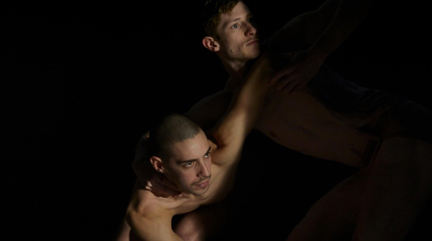
From “Eclipse” — © 2013 by David Cooper & Linda Arkelian.
improvised choreography was “sculpted” by the filmmakers. Arkelian explains, “We’d explain our lighting objective and then set up the shot accordingly. The dancers were either directed to move through the frame with a sequence — fast or slow, fluid or frenetic, leading and trailing out of frame with specific body parts — or they were set at a fixed or measured position in relationship to our lighting design, often with a mobile camera or mobile lighting to create various eclipse effects. The editing is really the hardest task. David does an amazing job piecing it together, which is challenging when the film does not have a full storyboard…. [But] I like the collaborative magic of allowing art to unravel without an expected
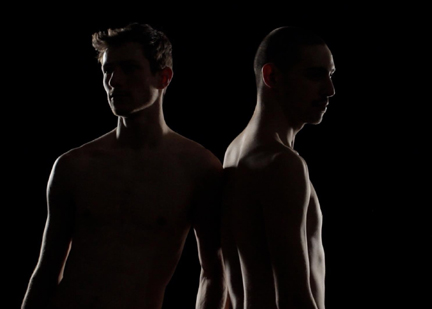
From “Eclipse” — © 2013 by Linda Arkelian & David Cooper.
conclusion.”
As to the choice of dancers, Arkelian explains that, “I selected Thibaut immediately because he moves in a very unique manner, with stunning precision and artistic focus. His close shaven head became an interesting focal point of our film from the onset. David was attracted to the idea of back lighting his head to set the eclipse theme for our opening title. These two male dancers share a similar physique that compliments each other. [At the same time] they are contrasting in character: Thibaut is very strong with dark features, penetrating eyes while Darren is soft, gentle natured and compliant with soft hair.”
At the conceptual stage, Arkelian envisaged “Eclipse” in these

Filmmakers Linda Arkelian & David Cooper, creators of “Eclipse,” at the 2015 San Francisco Dance Film Festival.
terms: “I am intrigued by focusing on the expressive qualities of isolated areas of the body [in order to] to sculpt the entwined bodies of two professional dancers with the use of theatrical lighting. I envision strong imagery contrasting the use of light and dark to evoke emotion. I am attracted to the concept of [selectively] concealing and revealing — to conjure mystique. I see dancers as partially eclipsed as they slip into shadow or are drawn into view. I would like to use dancers [who are] comfortable with partial nudity so we can capture muscle definition…. I believe there is great power in minimalism.”
The music for “Eclipse” is “We Move Lightly” by the American composer and pianist Dustin O’Halloran (who composed the score
for the 2013 feature film “Breathe In”), from his 2011 album “Lumiere.” It’s as lyrical and lilting as “Eclipse” itself — a most convivial union of moving images and music. As to his music’s eminent suitability for “Eclipse,” Arkelian explains that, “As a dancer, I am deeply motivated and moved by music. I had something very specific in mind for this concept. I wanted piano with the inclusion of strings to add layering and dialogue. Because it is a sensual duet for two men, I was interested in exploring strings for an element of sexual tension. I searched very long to find suitable music. When David first started editing the film we had no music to work with, so he compiled some space sounds. I liked this idea. We thought we could perhaps open our film with a space soundscape to establish the theme and then integrate a score with a melody into it. When I came across Dustin O’Halloran’s composition “We Move Lightly” I fell in love with its fluidity and sense of “lightness” simulating the weightlessness of space. The fact that it opened with an electronic ambiance lent itself to a perfect bridge from our ambient space introduction. I later learned that Dustin was contracted to compose the score to choreographer Wayne McGregor’s contemporary ballet “Atomus” in Britain in October 2013. I have great admiration for both the composer and the choreographer he was partnering up with in Europe. It lent me to believe that Dustin’s music is meant to come to life with dance.”
“Eclipse” is a strong follow-up to Cooper and Arkelian’s 2012 debut, positively immersed in the innocence, vulnerability, and grace alluded to earlier. It’s the best kind of non-narrative filmmaking, in which theme, music, cinematography, choreography, concept, direction, and editing yield a beautifully evocative result — a cosmic dance of the human race in its infancy striving to find its place among the stars. Let’s hope that more fruitful collaborations between these talented new filmmakers will follow — soon!
Copyright © October 2013 by John Arkelian.
“Eclipse” (Canada, 2013) (B+/A-) is directed by David Cooper and Linda Arkelian. It had its world premiere at the Cinechats Film Festival in Ontario, Canada in October 2013.
See “Eclipse” (duration 4:00 minutes) online at: http://vimeo.com/72348461
Editor’s Note: In October 2015, “Eclipse” was an official selection at the San Francisco Dance Film Festival: Filmmakers Linda Arkelian and David Cooper were in attendance.
****************************************************
“And Soaring Ever Singest — Stars on Ice”
© Reviewed by John Arkelian
“And singing still doth soar, and soaring ever singest.” What was true for the poet Shelley’s skylark was just as true for the eleven champion figure skaters
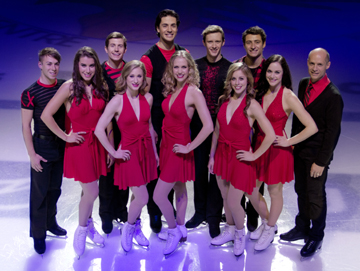
Artists of the ice: The cast of Stars on Ice
who comprised “Stars on Ice”* as they dazzled a large audience at Oshawa’s General Motors Center on May 1, 2012. Apart from the musical score, which drew heavily from pop, rock, jazz, and salsa, the singing here was metaphorical. But it was clear that the spirits of these artists of the ice sang and soared, as their sublime fusion of art and athleticism took the audience with them on an electrifying flight of the imagination.
Introduced as “the life of the party,” Shawn Sawyer’s high energy joie de vivre was palpable. Part mime, part acrobat, part clown, and all skater, Sawyer’s first solo was an exhilaratingly entertaining show-stopper. Another highlight came in fast succession, as Cynthia Phaneuf skated to salsa-sounds with an infectious beat, bathed in purple and magenta light and closing with a superlative spin. Joannie Rochette’s first number had a strong dance beat, too, while she was clad in skin-tight black latex like the femme fatale of the “Underworld” movies. A more conscious nod to the silver screen came later, with Kurt Browning, made up as an old man, remembering love found, then lost, with the soul-mate of his youth. This sweet, nostalgic piece was inspired by Disney’s “Up,” and it relied on pantomime for its storytelling. Elsewhere, Browning and two other men tap-danced on skates without music, before being joined by the rest of the cast and skating to an infectious pop song.

Kurt Browning (photo by Mike Okoniewski)
The sublimely beautiful Tessa Virtue (she of the marvelous nomenclature that sounds as if it sprang from the pen of Charles Dickens) and Scott Moir were achingly romantic and balletic skating to Leonard Cohen’s “Hallelujah.” Jeffrey Buttle put on an impressive show of speed and virility; while Kaitlin Weaver and Andrew Poje danced a romantically emotive pas de deux to a bittersweet song in French, with a succession of impressive and unusual lifts. Jeremy Abbott skated to a romantic country music ballad; and the show’s co-director, Kurt Browning, was a supple study in confidence and strength as he grabbed the audience with his skate to “It’s a New Day.” Not to be outdone, Sawyer started his second solo, to Cirque du Soleil’s “Allegria,” with acrobatics; the avant garde skating that followed was lithe, dramatic, and athletic. Ashley Wagner was the very embodiment of femininity, and a lyrical, classical style, skating to “How Wonderful Life is, Now That You’re in the World,” and there’s no doubt that those lyrics perfectly expressed the sentiments of the audience vis-à-vis the eleven skaters. We watched in sheer delight as these Olympic, World, and National champions combined their charisma and talent with Kurt Browning’s tour de force choreography. It’s rare to see performances of any kind — on the screen, stage, or ice — that so uplift, entertain, energize, and amaze. “Stars on Ice” is the sort of experience you’ll be wishing you could relive the very next day!
© May 2012 by John Arkelian.
*The official title of the show this year, “Investors Group Stars on Ice Presented by Lindt,” gives considerable prominence to its corporate sponsors, whose commercial plugs during the show itself were a wee bit heavy-handed.
*****************************************************************
“Hands” — A New Dance Film by Linda Arkelian & David Cooper
© Reviewed by John Arkelian
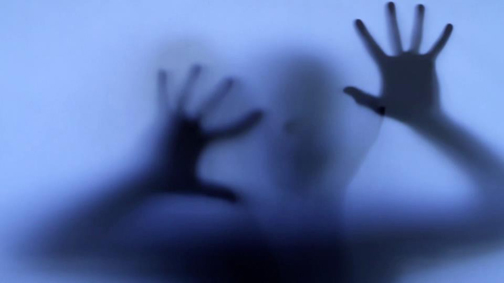
From “Hands” by David Cooper & Linda Arkelian. © 2012.
“My hand delights to trace unusual things,
And deviates from the known and common way;
Nor will in fading silks compose
Faintly the inimitable rose.”
Anne Finch, Lady Winchilsea (English poet, 1701)
The hand that delights to trace unusual things is the hand of an artist; and two such artists have combined their talents to produce a lovely expression of beauty in motion. “Hands” (Canada, 2012) is a short film from collaborators Linda Arkelian and David Cooper. She is a classically trained ballerina and choreographer, a veteran of the Royal Winnipeg Ballet (as well as Vancouver’s Anna Wyman and Judith Marcuse dance companies), and an acclaimed ballet and pointe teacher, whose interdisciplinary gatherings of artists have brought new and established musicians, visual artists, still photographers, and videographers to her dance studio. He is one of Canada’s preeminent dance photographers, an artist of the lens whose work sublimely captures that most ephemeral of things — the essence of movement— in still images. Their short dance film, “Hands,” choreographed by Arkelian and exquisitely filmed by Cooper (in motion pictures rather than still ones this time) in natural light is a gorgeous expression of movement and mood set to the note-perfect piano music of Canadian pianist and composer Stephan Moccio. His composition “Ow” (from his album “Exposure” on Universal Music) seems tailor made for this lovely, lyrical expression of dance’s ability to transfix, entrance, and enchant. It is gracefully, and at times playfully, performed by Arkelian. In the second century A.D., a theologian noted that we enter the world with hands clenched and leave it with palms spread open. In this delightful film, the hands are open — and wonderfully expressive. Cooper and Arkelian have conjured magic here. Let’s hope they will enter “Hands” in festivals in Canada and abroad and that the pair will combine their considerable talents again for more forays into what lies beyond ‘the known and common way.’
Copyright © March 2012 by John Arkelian
“Hands” (Canada, 2012) (B+/A-) is directed by David Cooper and Linda Arkelian. It had its world premiere at the Cinechats Film Festival in Ontario, Canada in March 2012.
“Hands” (duration 3:21) is available for viewing online at:
http://vimeo.com/37639703
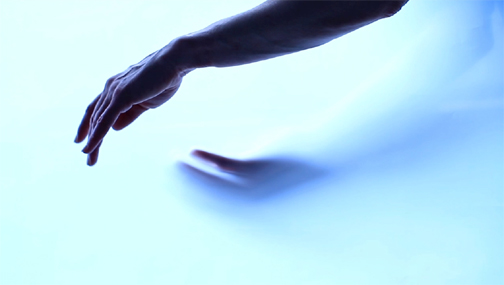
From “Hands” by Linda Arkelian & David Cooper. © 2012.

